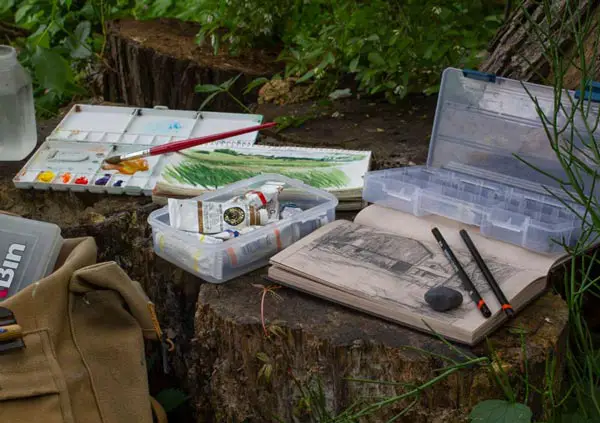
Essential Items for a Field Sketching Kit
Having the right tools and materials for sketching outdoors can make the difference between a successful day of sketching or a miserable one. Nothing is more frustrating than arriving at your sketching destination and finding out you forgot your pencils or watercolor brushes. So that brings up the question, what are the essential items for a field sketching kit?
Sketching materials will be heavily dependent on two important factors: your medium, and where you are going to sketch. Pencil sketching requires the least amount of materials, watercolor requires additional items such as paints and brushes, and long-distance hiking requires portable materials.
Below we will discuss what items you would have on hand for sketching and drawing outdoors and some recommended materials to help you get started.
Make Sure You Have a Good Sketchbook or Sketchpad
The first thing you will need is something to draw on. Thankfully there are many sketchbooks and pads on the market for reasonable prices. I recommend a sketchbook over a drawing pad as the covers of a sketchbook tend to be more sturdy for transportation and do a better job of protecting the pages.
Case-Bound Verses Spiral-Bound Sketchbooks
There are essentially two types of sketchbooks: books with spiral binding, or case binding.
Case binding is basically what you get with a typical hardcover book. Sketchbooks with this type of binding are better for durability and preventing smudging. The one possible drawback is that with some brands you cannot get the pages toward the center of the book to lay flat when drawing. I recommend and use sketchbooks with case binding for outdoor and field sketching since they tend to be more durable.
Sketchbooks with spiral binding allow you to easily remove pages. This is great for extracting and framing sketches you really like, and you can get the pages to lie completely flat. But spiral-bound pads make your drawings more susceptible to smudging. I recommend and use sketchbooks with spiral binding for indoor sketches and developing ideas for paintings as I can easily remove the sketch for scanning and enlarging.
Sketchbooks for Pencil Drawing
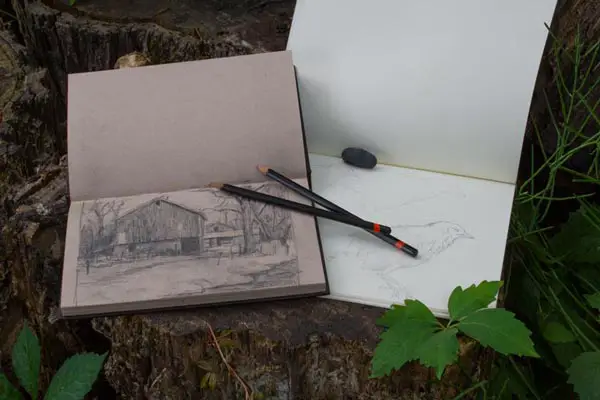
I use three different sizes of sketchbooks depending on what I'm drawing. I like smaller books for planning compositions, medium (around 8 1/2 x 11 inches) for sketching outdoors, and larger books or pads for sketching subjects that require details and accuracy.
One of my favorite sketchbooks for field use is the Strathmore Softcover 400 Series Sketch Artist Journal. It's a nice compromise between a case-bound and a wire-bound book. The pages are securely bound, yet you can get them very flat. The softcover has enough support for the pages you are drawing on and it has a great classic feel. These usually run for $10-$15 depending on the size. Click links on the Resources Page to see the current price.
If you like drawing on toned paper as I do, Strathmore makes a great hardcover, case-bound book with tan or gray 400 Series paper. The book lies pretty flat and the paper is smooth high-quality stuff. See Resources Page for more information and availability on both the regular and toned paper.
There are many other options depending on what type of paper you like as well as binding and cover type. Check out places like Blick Art Supplies or Utrecht Art Supplies to see some of the many options available.
See below for watercolor sketchbooks.
Bring Along Several Pencils or Pens
The next thing you will need is something to draw with. Pencils are the primary instrument for sketching. But there are other options to consider. I spent a year sketching with just a ballpoint pen to break my over-dependence on erasers. Ballpoint pens are nice because they dry fast and don't smudge. Other options are charcoal (they will smudge), marker, watercolor, pastel, colored pencil, oil and so on. If it makes a mark it's game.
For the serious artist, it's always a good idea to have a small sketchbook and pencil on hand in case you ever want to sketch something spontaneously. You never know when an opportunity will present itself.
If you are doing any amount of traveling for the purpose of sketching, make sure you bring along at least several pencils or pens. There have been many times when I dropped a pencil in between rocks or some other unreachable place. In that situation, having only one pencil will end your sketching and even your sketching day very abruptly. See the Resources Page for recommended pencils.
Traditional pen and ink can be a fun way to sketch outdoors and was the method used by many artists from the 19th century on back. Make sure the ink is stored in a thick, glass, or plastic inkwell with a tight cover to avoid breaking and causing a mess. Also, ensure the pen is safely transported so as to not damage the fragile nib. Do this by removing the nib from the pen if possible. John Neal Books is my favorite resource for these items.
Pencil Cases for Sketching Outdoors
While you can sketch outdoors without one, having some type of case to store and transport your pencils is very handy. Pencils are not very big and can easily get lost (believe me, I've lost many). Keeping them in a case not only helps you keep track of them, but it can also protect them from damage.
Many art supply stores sell pencils cases. My pencil case is actually a small fishing tackle box that I picked up at Bass Pro Shop. It has adjustable dividers that come in handy. This used to be the most cost-effective box I could find, but Artbin now offers a pencil box for around the same price (see bottom of the Resources Page) and theirs has a convenient foam insert at the end to prevent your sharpened pencils from getting damaged.
Make Sure You Can Sharpen Your Pencils
It may seem obvious that you should bring your pencil sharpener with you when sketching outdoors, but there have been a number of times when I have forgotten mine. You can use a typical hand-held sharpener which is easy to carry. Bring a couple along in case you lose one. Another option is a small retractable razor and a small piece of sandpaper.
Have Several Good Erasers For Outdoor Sketching
For the same reason as mentioned above, you will want at least several erasers for outdoor sketching. Besides dropping an eraser in a spot you cannot reach, you may drop it in some mud which could make it unusable. Some kneaded erasers can get a little sticky and dropping it into some sand could ruin it.
It's always a good idea when sketching to not rely too much on an eraser. The purpose of field sketching is to capture a moment and make a visual note, not create and award-winning drawing. Yet it's nice to have the option to erase big blunders or get rid of a couple of lines on a page because the subject ran away right after you started drawing. Just make sure you have several onhand.
There are many erasers on the market. I tend to prefer a kneaded eraser because of its gentleness, longevity, and ability to move into different shapes (see Resources Page). Experiment and see which type you like best.
A Backpack for Carrying Your Items
A backpack is very handy, not just for hiking somewhere, but also for keeping all your items together for a convenient grab and go approach. You can also use a tote bag or anything else that will help you keep your sketching stuff together and get it to where you need to go.
For my pencil and watercolor sketching materials, I use a simple backpack. I can also carry food and water in it. For my plein air oil painting items (which is way more extensive), I use a large mountain hiking backpack. Military surplus stores can be great places to find quality backpacks at a reasonable price.
Consider Sunscreen, Bug Repellent and an Umbrella
If you are going to be outdoors for a while it's a good idea to bring sunscreen. I usually try to put it on before I leave. That way if I see something that I get really excited to draw or paint, or something that is fleeting (which happens a lot), I won't forget to apply it on location.
One note of caution, be sure not to rub sunscreen in your eyes. I've done that and was unable to draw or paint due to eye irritation.
I was raised in Minnesota which is mosquito country. I've literally been swarmed, making it impossible to paint. Depending on how bad the bugs are in your area, bring some bug repellent along. Also, be on the lookout for deer ticks that carry Lymes Disease. I've contracted it and know other artists who have contracted it at least five times or more.
I use an umbrella more for plein air painting than for drawing. When my painting surface and palette are in direct sunlight, I have a tendency to paint dark to compensate for the brightness. Painting under an umbrella keeps me from creating dark, drab field studies. Make sure the underside of the umbrella is dark so you don't have ambient light bouncing all over throwing off your colors.
Bring Food and Water for Long Sketching Trips
Bring some food and water if you will be out for a while, especially if it's going to be hot.
They make some great water bottles with built-in filters. You can fill these bottles up with clear lake or stream water and drink it (read the manufacturer's label before using). I used one while painting in the Rocky Mountains and it made an all-day painting hike so much easier. Rather than lugging eight bottles of water, I was able to fill up just one filter bottle with ice-cold alpine lake water whenever needed.
If you are painting, make sure you bring food that doesn't have to be exposed to your bare and possibly dirty or paint-stained hands. You don't want any toxic paint getting from your hands to your food. Hold your sandwich with a wrapper. Granola bars or something similar is good. Bananas are a really great option since you can hold the peel. Apples and oranges are probably out of the question.
Essential Items for Sketching Watercolor Outdoors

Next to colored pencils, watercolor is probably the most portable-friendly color medium for sketching outdoors. Here is a small list of what you will need for sketching outdoors with watercolor:
- A watercolor sketchbook
- Watercolor pigments (ether pan or tube paint)
- A palette (many pan watercolor kits come in a palette)
- Brushes
- Brush Box
- Some type of water container
- Paper towels
- A bag to transport and dispose of used paper towels
- A backpack to transport these materials
- A portable chair to sit on (not necessary but helpful)
Sketchbooks for Watercolor
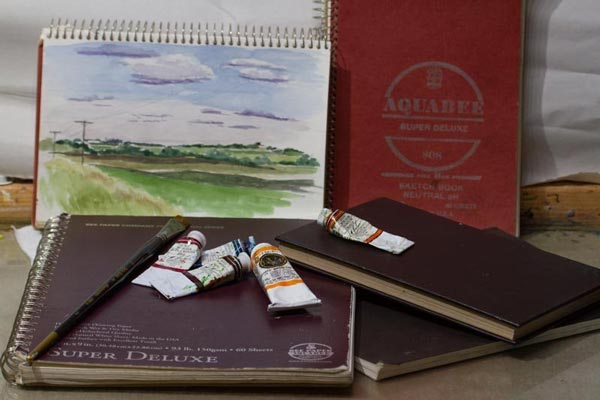
Using watercolor on regular paper can be a nightmare. Not only will the pages buckle, but repeated washes can end up literally destroying the paper. Fortunately, there are many options for the watercolorist who wants to sketch outdoors. These range from hardbound books to spiral-bound pads. You can also find a wide variety of paper textures from smooth hot-press to rough cold-press.
The Aquabee Super Deluxe Sketchbook is a great option! I used this one a lot back in my watercolor days. The paper is very good quality and smooth so you can use it for both watercolor and pencil sketches. I used a combination of pen and ink and watercolor and it worked perfectly!
If you want to focus mostly on watercolor with a lot of washes, you may want to try a thicker cold-pressed paper with more texture. Once again Strathmore makes sketch journals with 400 Series paper that open flat and come in both landscape and portrait formats.
Another option is using a watercolor block. This is a pad of watercolor paper that is glued on all four sides of the paper. The nice thing about this is having all four sides glued helps keep the paper from buckling, which allows you to do repeated washes. I have to note that the paper will still buckle if enough water is applied, but the buckling is still less than a regular sketchpad. Arches makes great watercolor blocks. See the Resources Page for pricing and availability on the two above items.
There is a drawback to using blocks for field sketching. You need to use a razor to cut the binding on all four sides to remove the top paper before you can use the next sheet of paper underneath. Then you need to put the loose sheet of paper somewhere safe which could be a challenge if you have backpacked a long distance.
Watercolor Paints for Field Sketching

Watercolor paint come in two basic types, pan and tube pigments. Pan paint consists of dried pigment in a little square that is activated when water is applied. Tube paint is wet paint in a tube that you squeeze onto a palette. Tube paints eventually dry and becomes pan pigment which can be reused by activating with water.
I prefer to use tube paint. It more you have to lug along, but I like the options of being able to use thicker paint if need be. I prefer are Da Vinci watercolors, but also use M. Graham. If you intend to focus on more transparent washes and would like to significantly reduce your carrying load, pan colors would be a better option.
Sakura Koi makes a very convenient watercolor pan set that includes a palette and a brush that allows you to fill the handle with water. It comes in sets from 12 up to 72 colors and you can buy refill pans for just a few bucks. The paint is student grade, but for personal sketches, this has never been an issue for me. See the Resources Page for availability.
Watercolor Palettes for Field Sketching
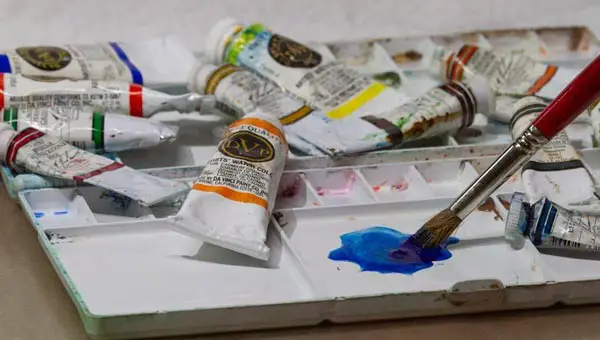
If you are going to use tube watercolors, or if your set of pan watercolors doesn't have an attached palette, you will need a separate palette for mixing colors. Folding watercolor palettes work great for field sketching. They have color wells and mixing areas and will close up to protect the pigments and the other items in your backpack.
I've used the Masters International Folding Watercolor Palette for years now and really like it. It's 4x8 inches, has 20 color wells, five mixing areas, three brush holes, and a thumbhole. You may want to wrap a rubber band around it to make sure it stays shut in your backpack (A good idea for any folding palette). See the Resources Page for availability.
Watercolor Brushes for Field Sketching

For watercolor brushes, I've used a combination of synthetic and natural sable in both flats and rounds. I primarily use Blick Masterstroke Finest Red Sable Brushes. I've found them to be a quality brush for a reasonable price (see the Resources Page for links to current price) especially for natural sable. I've had mine for years and they are still working well.
Another place to get great brushes is Rosemary & Co. in Great Britain. They have a wide variety of brushes and overseas shipping is generally quick and reasonable.
A note of caution, don't leave your brushes to soak in water for long periods of time. This can cause the glue that holds the brush together to weaken.
Brush Box for Watercolor Sketching
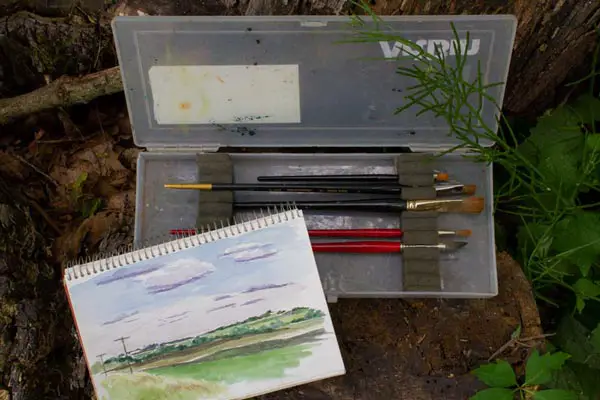
To carry my watercolor brushes into the field, I use a Brush Box made by ArtBin. It's large enough for long-handled brushes and has a foam insert to hold the brushes in place. This is important for protecting the delicate hairs on a watercolor brush. See the Resources Page for availability.
Water Container for Watercolor Field Sketching
You will need some type of container to hold water for sketching outdoors in watercolor. I just use whatever small water containers are available at any discount retail store. Just make sure it has a solid lid that won't come off. I've actually used lake or stream water to fill my container while out in the field. As long as it's clear water, it works fine.
Paper Towels for Watercolor Field Sketching
While any brand will suffice, my favorite paper towels for painting are Viva. They have a cloth-like feel and tend to absorb more than other brands. Just be careful when painting around water. I've dropped entire rolls in water which made them unusable.
Disposal Bag for Used Paper Towels
You will also want to have something to dispose of used paper towel sheets. I use the plastic bags you get at grocery and discount retailers. If it's windy you may have to weigh them down with a rock or some dirt. Just don't leave used paper towels out in the field. Some pigments contain toxins that you want to keep out of the environment.
Backpacks for Watercolor Sketching
This topic was already covered above. As said, you can also use a tote bag if you are not traveling very far.
Portable Chair for Watercolor Sketching
When I oil paint outside I usually stand, but since I'm using a sketchbook that I have to hold, I find it easier to sit for watercolor sketching. I use a fold-up three-legged stool. While not the most comfortable for long-term sitting (they sometimes cut off the circulation in my legs), they are small and easy to transport. They can be found at outdoor sporting good stores and certain discount retailers.
Sketching Outdoors is Unique to Every Artist
What I've provided is a list of what I use that hopefully will help you get started, and depending on the person, this list is by no means complete. I have been around many artists over the years and have yet to find one who uses the exact same materials that I do. Experiment until you find what works best for you and will make your outdoor sketching experience an enjoyable one.
Keep Sketching!
Heads up: my posts may contain affiliate links. If you buy something through one of those links, you won’t pay one penny more, but I receive a small commission, which helps keep this website going.
Jason Tako is a nationally known fine artist who specializes in western, wildlife, plein air, and Historical Native American subject matter. He spent his learning years sketching the wetlands and wooded areas of rural Minnesota. He has been featured in Plein Air Magazine and Western Art Collector Magazine and he was the Featured Artist for the 2020 Southeastern Wildlife Expo. See his work at www.JasonTako.com and his demonstrations on his YouTube Channel.
Warning: Undefined array key "preview" in /home3/mysketc2/public_html/wp-content/plugins/oxygen/component-framework/components/classes/comment-form.class.php on line 75
Warning: Undefined array key "preview" in /home3/mysketc2/public_html/wp-content/plugins/oxygen/component-framework/components/classes/comment-form.class.php on line 79